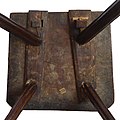Table
The table , also called a peasant chair or board chair , in Alemannic dialect also sidele, is a chair with four sloping legs that stick in a ridge bar grooved with a dovetail . This construction allows the massive seat sheet to work without warping. The table often has a decoupled , carved backrest that is embedded in the seat board and wedged below. Traditionally, the backrest sheet is used to stabilize the rear legs. This then leads to two slots in the seat board. Today, however, you will find the construction with only one slot in the seat board.
A form of the table, which is particularly widespread in Graubünden (Switzerland), is constructed without burrs. The slightly conical, long, slender, square or octagonal legs are carved into a round tenon at the end , which is split in the middle. The peg is embedded in a completely drilled hole in the seat board so that it is visible on the surface. A wedge is driven into the split center of the peg so that the chair leg is firmly fixed in the seat board.
From the 16th century onwards, the table replaced the stool as everyday seating in the country .
Like the related Italian sgabello , the word goes back to the Latin scabellum 'stool', from which today's Swiss-German sound variants Schkaeball, Schabeball and Stabälle have developed. The latter two are adaptations of the Schk- , which is foreign to the German language, into the Alemannic sound system. In the standard Swiss high German language, only the third variant occurs.
gallery
Web links
Individual evidence
- ↑ Schweizerisches Idiotikon , Volume VIII, Column 24 f., Article Schabëlle n ( digitized version ) and Volume X, columns 1–3, Article Skabëlle n ( digitized version ).
- ^ Hans Bickel , Christoph Landolt : Swiss High German. Dictionary of the standard language in German-speaking Switzerland. 2nd, completely revised and expanded edition, published by the Swiss Association for the German Language. Dudenverlag, Berlin 2018, p. 77.





